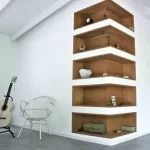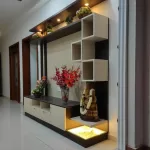Common Mistakes in the Design of the Entrance and How to Avoid Them
The entrance of your home is the first impression visitors get when they arrive. It’s not just a transition from the outside to the inside but a space that sets the tone for the rest of the home. A well-designed entrance can elevate the entire ambiance, while a poorly designed one can make your home feel uninviting. In this article, we’ll discuss common mistakes in entrance design and how to avoid them to ensure your entryway is functional, stylish, and welcoming.
1. Ignoring Functionality
While aesthetics are important, the functionality of your entrance should be a top priority. One of the most common mistakes is neglecting to consider how the space will actually be used. An entrance that is too cramped, poorly lit, or lacks adequate storage can quickly become a source of frustration.
How to Avoid This Mistake:
- Prioritize Traffic Flow: Ensure that the entrance provides enough space for people to move freely. Avoid placing bulky furniture or obstacles that can restrict movement.
- Incorporate Storage: Add functional storage solutions like a coat rack, shoe storage, or a console table to keep the area organized and clutter-free.
- Use Practical Lighting: Make sure your entrance is well-lit, with either natural light or strategically placed light fixtures to ensure visibility, especially during nighttime.
2. Failing to Define the Space
Sometimes, the entrance can feel like just an afterthought or a forgotten space in the home. Not properly defining the area can result in a disjointed or unclear design. The entrance should feel like a distinct and inviting transition zone.
How to Avoid This Mistake:
- Use Flooring or Rugs: Differentiate the entrance from the rest of the house by using unique flooring materials like tiles, stone, or a rug that adds warmth and character.
- Create a Focal Point: Make the entrance memorable by adding a striking piece of furniture or artwork that immediately draws the eye upon entering the home.
- Establish a Clear Path: Use lighting, a distinct color scheme, or furniture arrangement to help guide visitors into the home and direct them naturally to the next area.
3. Overcrowding the Space
Overcrowding the entrance with too much furniture, decoration, or accessories is a common mistake. A cluttered entryway can make the space feel smaller and less inviting. It can also make it difficult to move freely or store essentials.
How to Avoid This Mistake:
- Limit Furniture: Choose minimal, practical furniture like a slim console table or a small bench to avoid overwhelming the space.
- Use Vertical Space: Maximize wall-mounted storage options, like hooks for coats and hats, or shelves for decorative pieces, to keep the floor area uncluttered.
- Edit Accessories: Keep accessories to a minimum. One or two key pieces of decor, like a statement vase or artwork, will add interest without making the space feel crowded.
4. Not Considering the Exterior
The design of the entrance extends beyond just the interior space. The exterior of your entrance, such as the front door, porch, or landscaping, is equally important in creating a welcoming first impression.
How to Avoid This Mistake:
- Choose a Statement Door: The front door should be visually appealing and complement the overall design of your home. Opt for a color or material that stands out but also coordinates with the rest of the exterior.
- Landscaping and Lighting: Consider adding plants, flowers, or outdoor lighting to enhance the exterior entrance and create an inviting atmosphere.
- Weather Protection: If your climate demands it, add a porch or awning to protect the entrance from the elements, making it more comfortable and practical.
5. Poor Lighting Design
Lighting is a critical aspect of entrance design, but it is often overlooked. Without proper lighting, the entrance can feel dark and uninviting, especially at night. It can also make it difficult for visitors to see the details of the space, such as artwork, decor, or pathways.
How to Avoid This Mistake:
- Layered Lighting: Use a combination of ambient, task, and accent lighting. Install overhead lighting for general illumination, add sconces for wall lighting, and use floor lamps or table lamps for accent lighting.
- Smart Lighting Choices: Choose warm-toned bulbs for a cozy, welcoming feel. You can also install motion-sensing lights for added convenience, especially for outdoor areas.
- Highlight Key Features: Direct light toward important elements in the entrance, such as a beautiful mirror, artwork, or the front door itself, to enhance the overall design.
6. Forgetting About Seasonal Changes
An entrance should be designed to work in all seasons, but many homeowners fail to consider the impact of changing weather. Whether it’s the harsh sun of summer or the cold winds of winter, the entrance should be adaptable to these shifts.
How to Avoid This Mistake:
- Durable Materials: Use materials that can withstand the elements, especially for outdoor elements like the front door, floor, and furniture.
- Seasonal Decorations: Consider adding removable accessories that can change with the seasons, such as plants, wreaths, or seasonal throw pillows.
- Protection from the Elements: If you live in a place with extreme weather, consider adding awnings or overhangs to protect both the entrance and guests from rain, snow, or heat.
7. Disregarding Personal Style
While it’s easy to focus on trends or what’s popular, the entrance should reflect your personal style and complement the overall aesthetic of your home. A space that lacks personality or seems too generic can feel uninviting.
How to Avoid This Mistake:
- Choose Personal Touches: Incorporate elements that resonate with your taste, such as a vintage rug, artwork, or unique lighting fixtures.
- Coordinate with the Home’s Overall Style: Ensure that the design of the entrance aligns with the theme of your home, whether it’s contemporary, traditional, minimalist, or eclectic.
- Balance Function and Aesthetics: While it’s important for your entrance to look stylish, don’t sacrifice function. Aesthetic elements should be complemented by practical features that enhance the user experience.
8. Neglecting the Importance of Color
Color plays a key role in shaping the atmosphere of the entrance. Some people make the mistake of either choosing too many bold colors or playing it too safe with neutrals, creating an entrance that doesn’t feel cohesive.
How to Avoid This Mistake:
- Use a Cohesive Palette: Choose a color scheme that complements the rest of your home’s interior and exterior design. Neutral colors like white, gray, and beige can create a calming effect, while vibrant hues can make the space pop.
- Accent Colors: Use accent colors for added interest, whether it’s through accessories like rugs, lamps, or art pieces. A pop of color can bring personality to the entrance without overwhelming it.
- Consider the Mood: Think about the mood you want to evoke. Soft, light colors make the space feel airy and welcoming, while darker tones can create a more dramatic, sophisticated look.
9. Skipping the Details
The little details can make a huge difference in the design of the entrance. Small design elements such as door handles, welcome mats, or mirrors can elevate the space and make it feel complete.
How to Avoid This Mistake:
- Invest in Hardware: Choose stylish door handles, locks, and hinges that complement the rest of the entrance design.
- Add Mirrors: A mirror in the entrance not only enhances the space visually but also provides a functional spot for last-minute check-ups before heading out.
- Personalize the Entryway: Include a few personal items, like a framed family photo, decorative bowl, or plants, to make the space feel truly yours.
10. Overlooking Safety and Security
Finally, neglecting the safety and security of your entrance is a serious mistake. The entryway is the most vulnerable part of your home, so it’s important to design it in a way that offers protection without sacrificing style.
How to Avoid This Mistake:
- Install a Solid Door: Choose a sturdy, high-quality door made of wood or metal to ensure safety.
- Security Lighting: Install motion-sensing lights around the entrance to deter intruders and ensure visibility at night.
- Reinforce Locks: Make sure that locks and handles are secure, and consider smart security systems for added peace of mind.
Conclusion
Designing a welcoming and functional entrance is crucial for making a positive first impression. Avoiding these common mistakes will help you create an entrance that is not only beautiful but also practical and secure. By considering the right lighting, furniture, color scheme, and layout, you can make your entrance a space that complements your home’s overall design while also offering ease of use and comfort.


